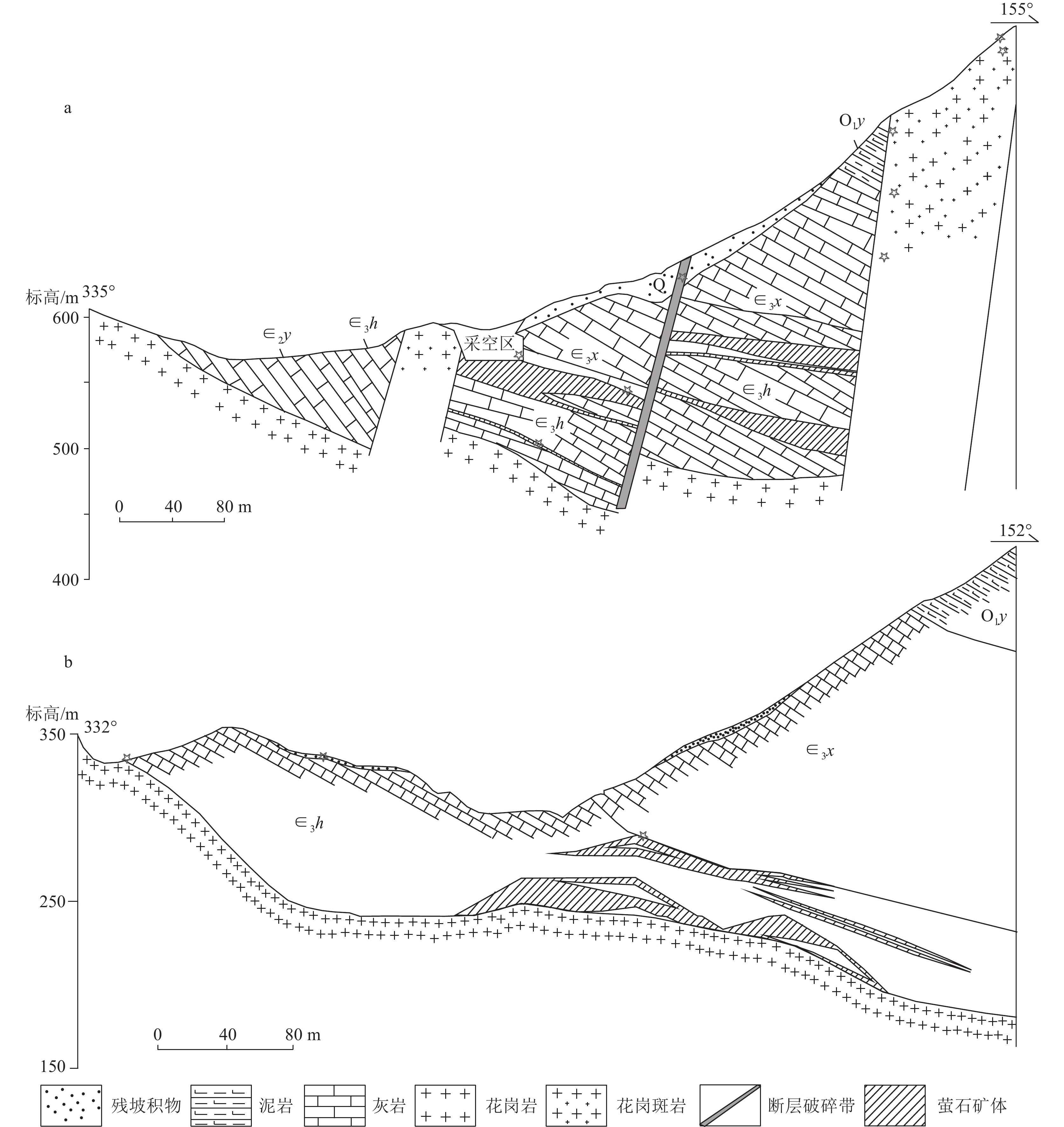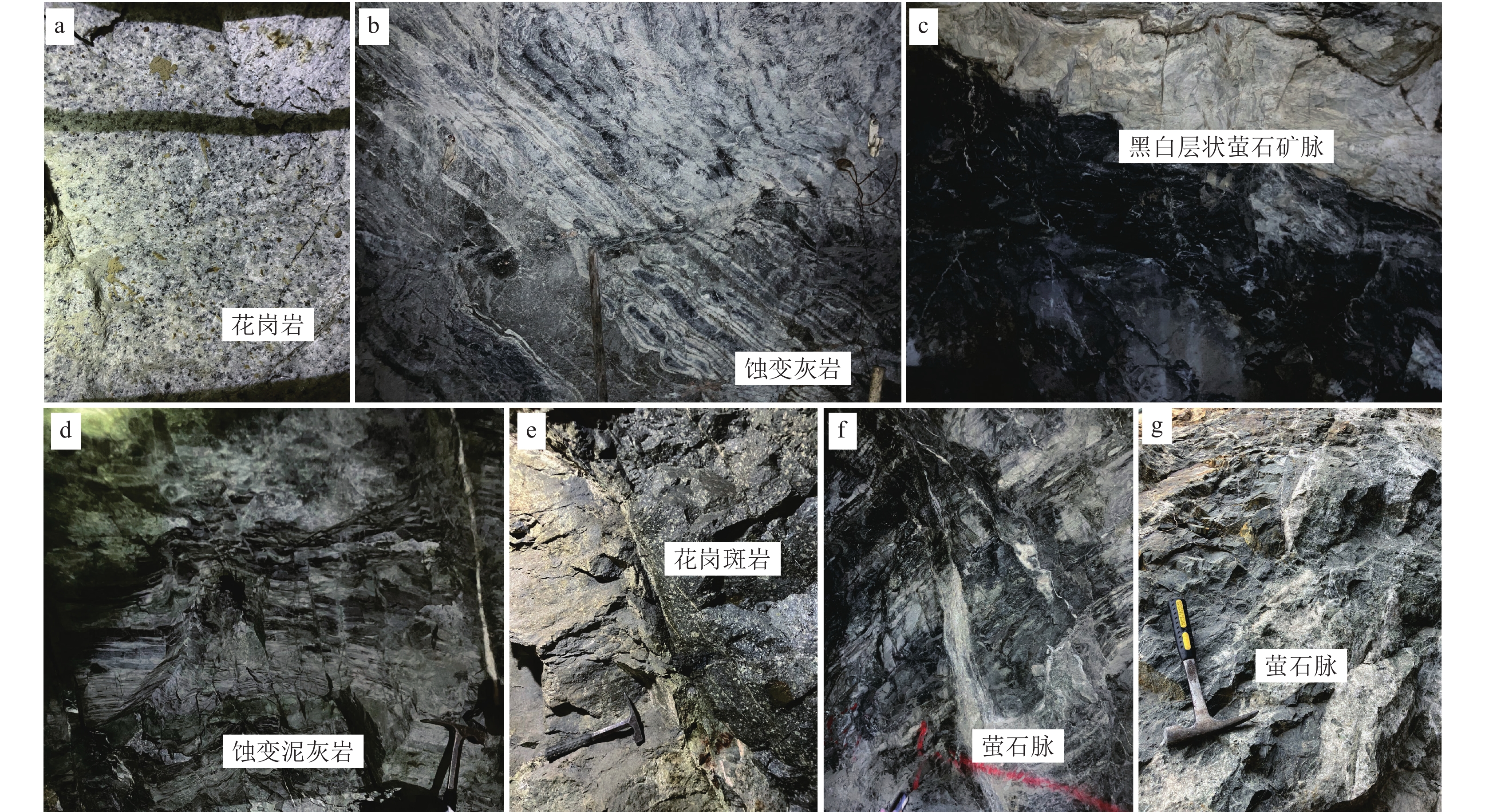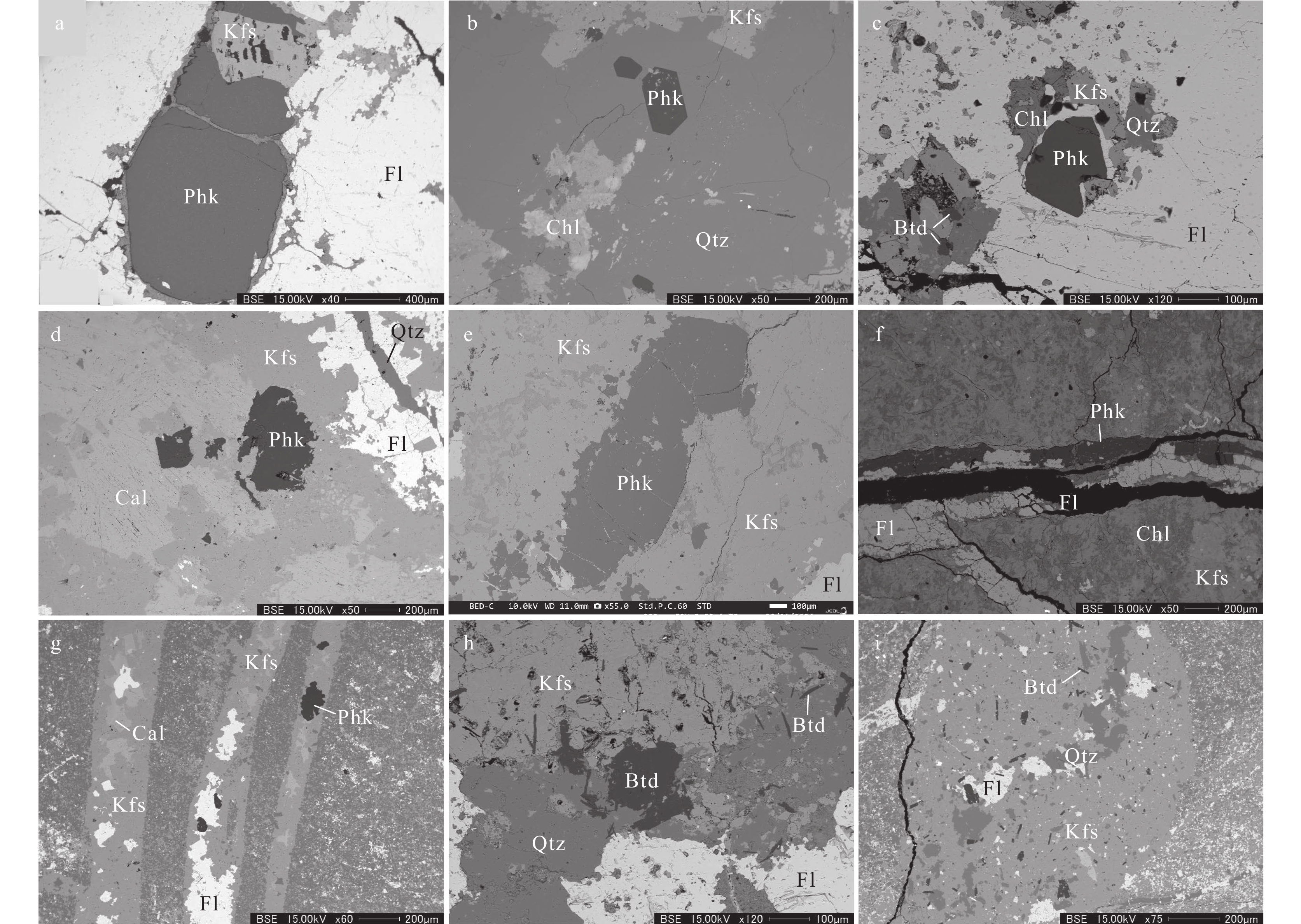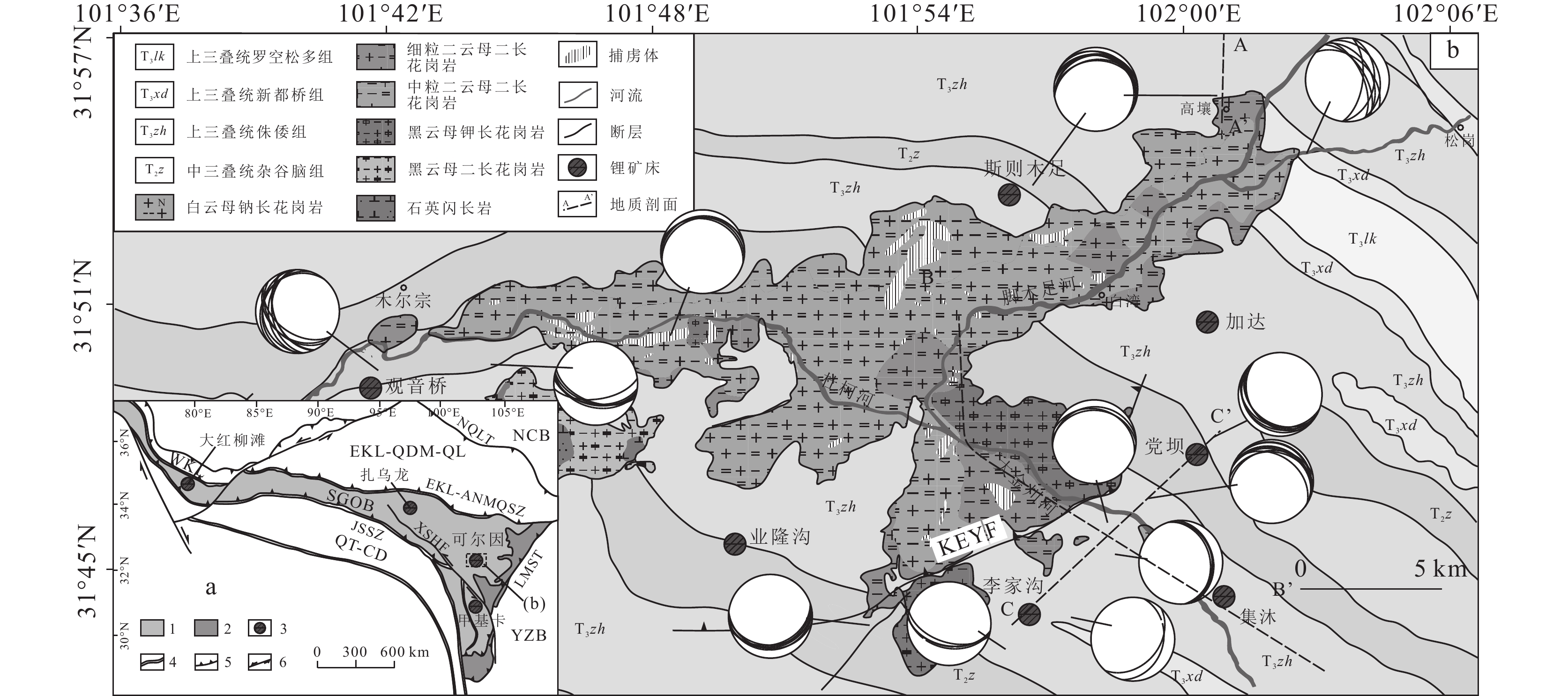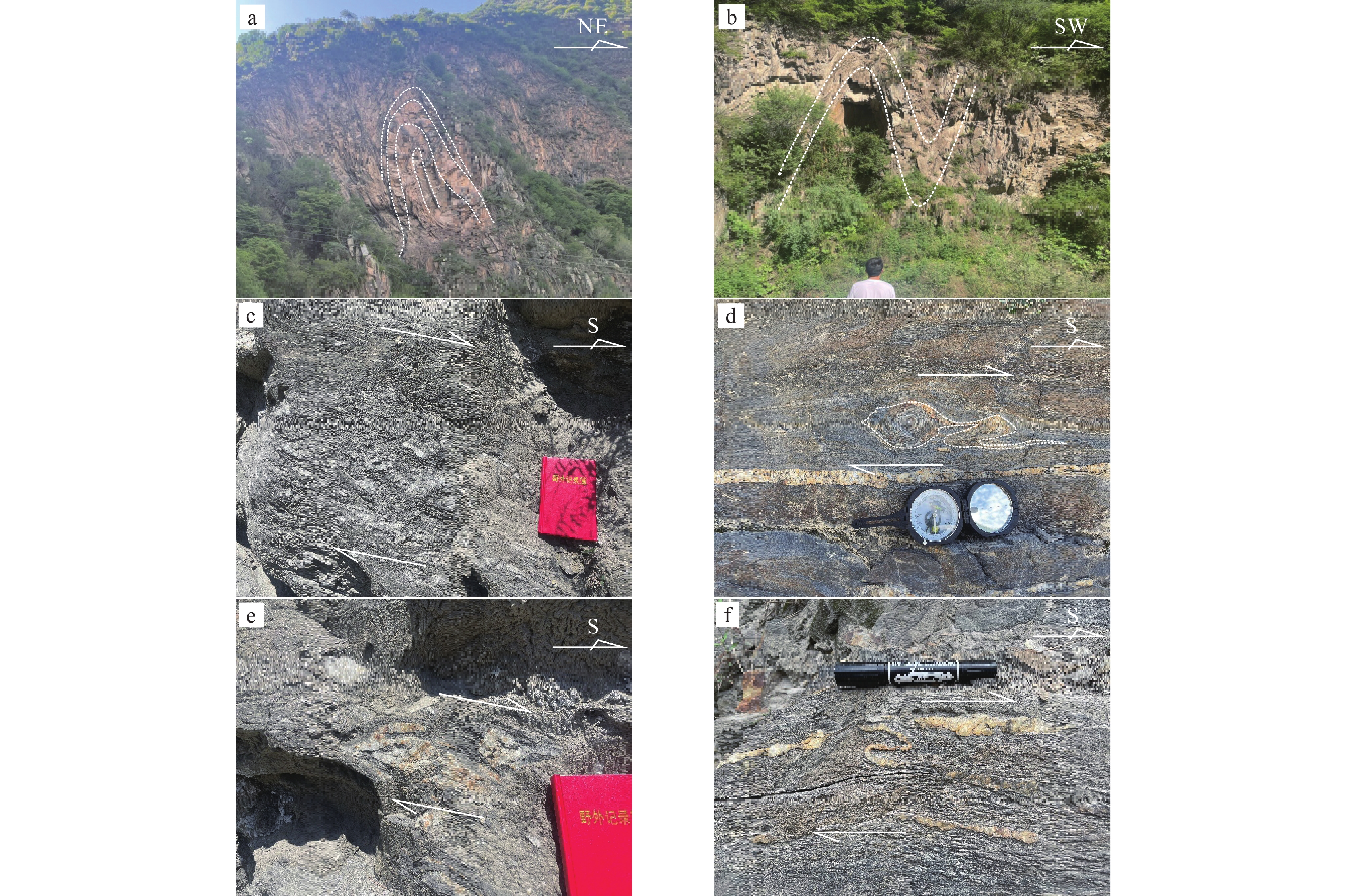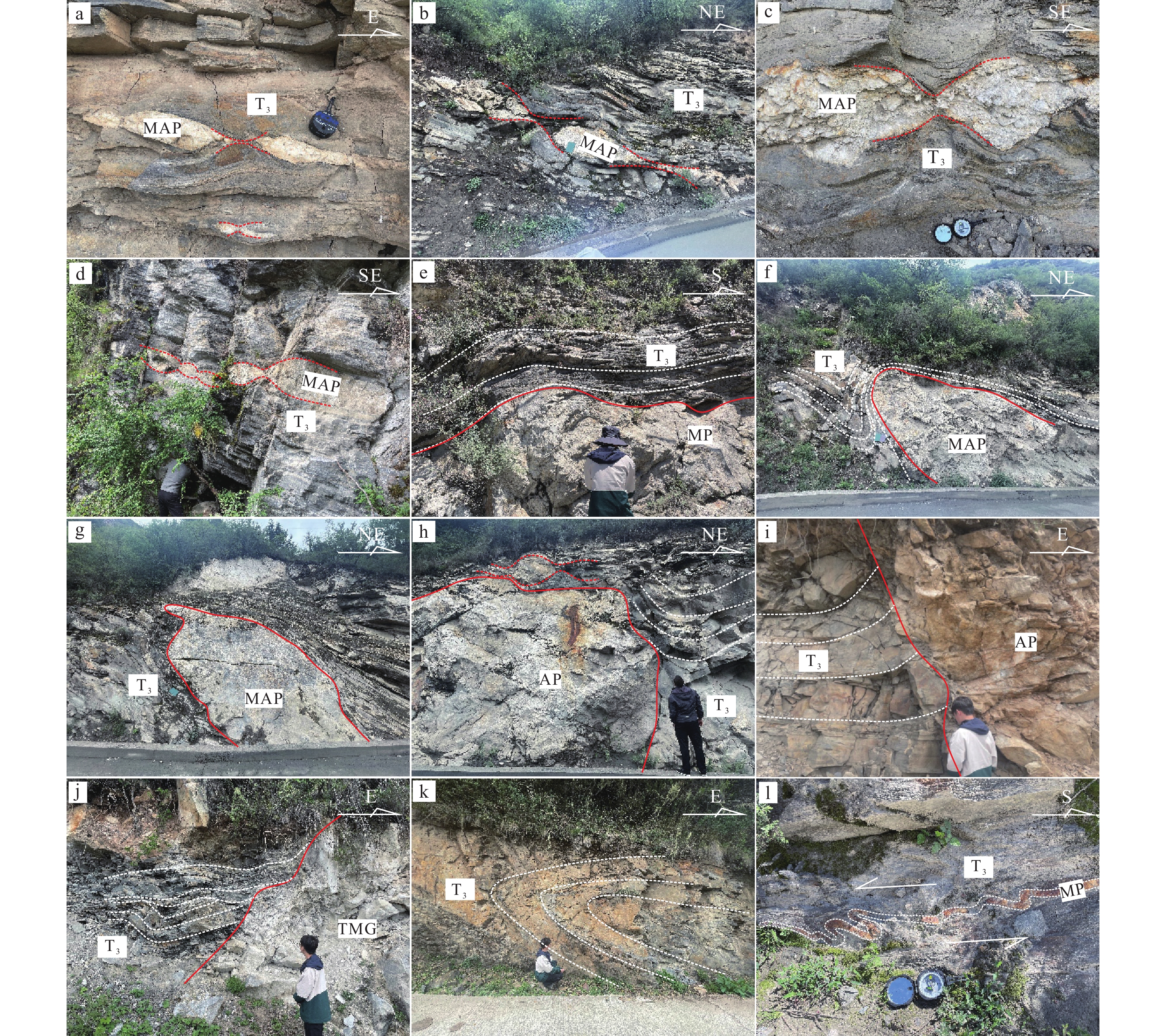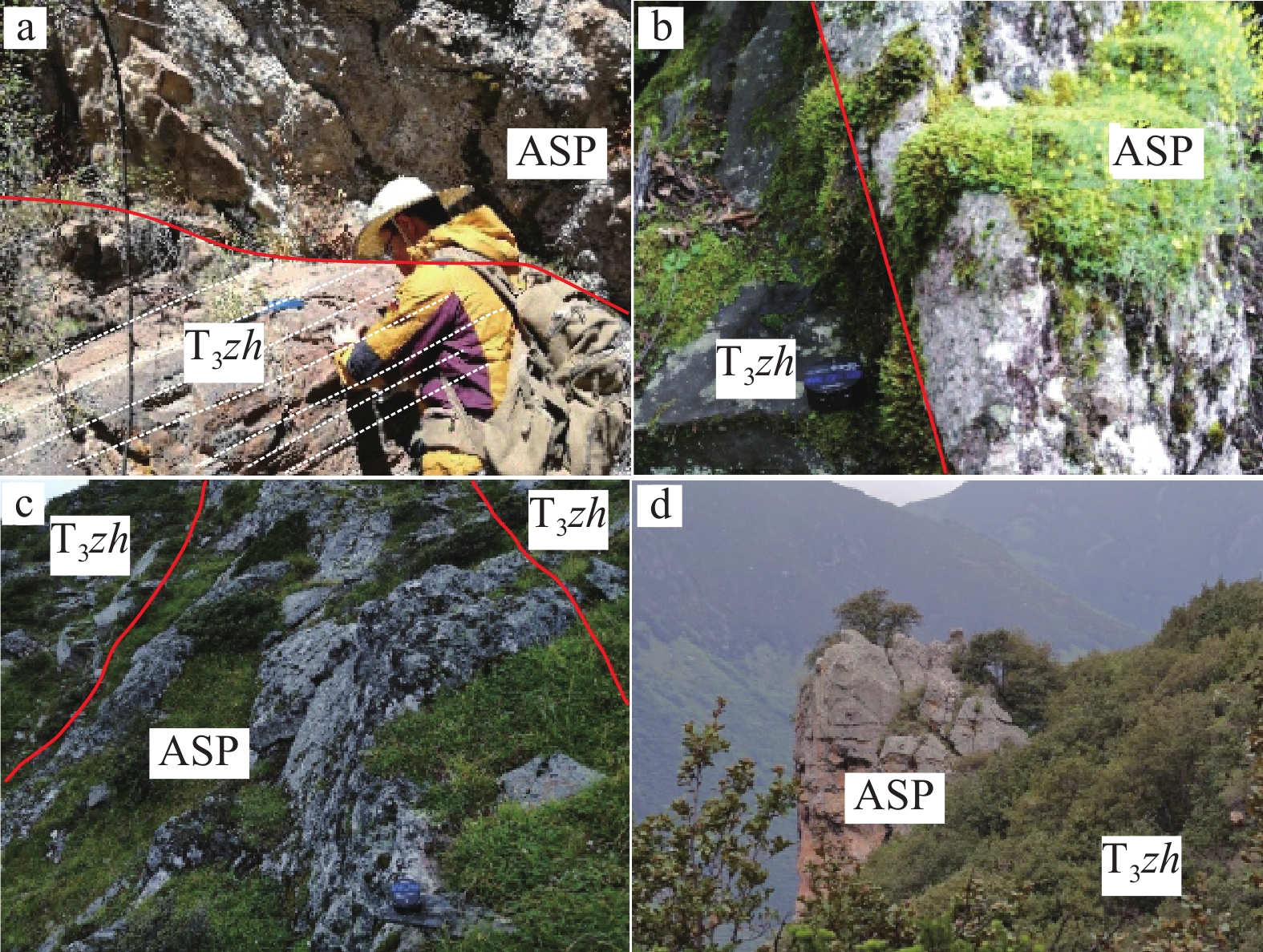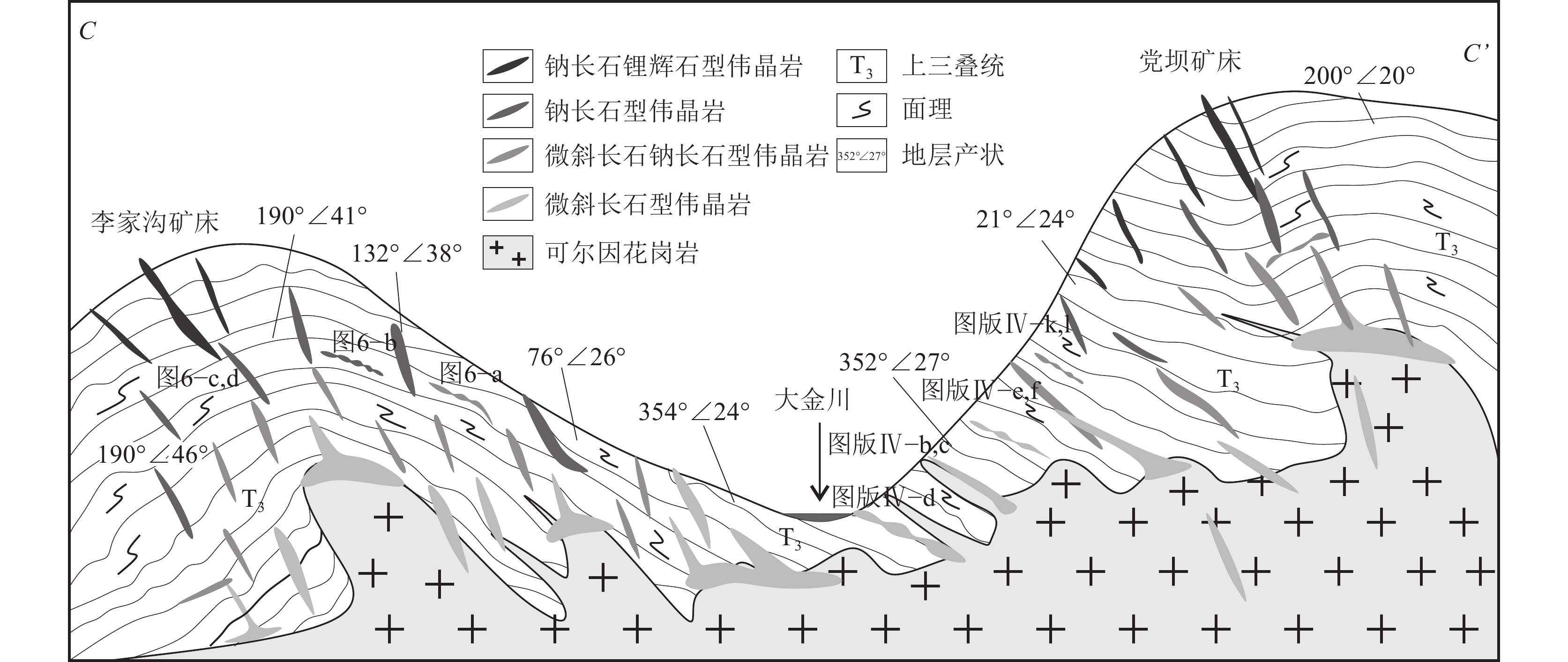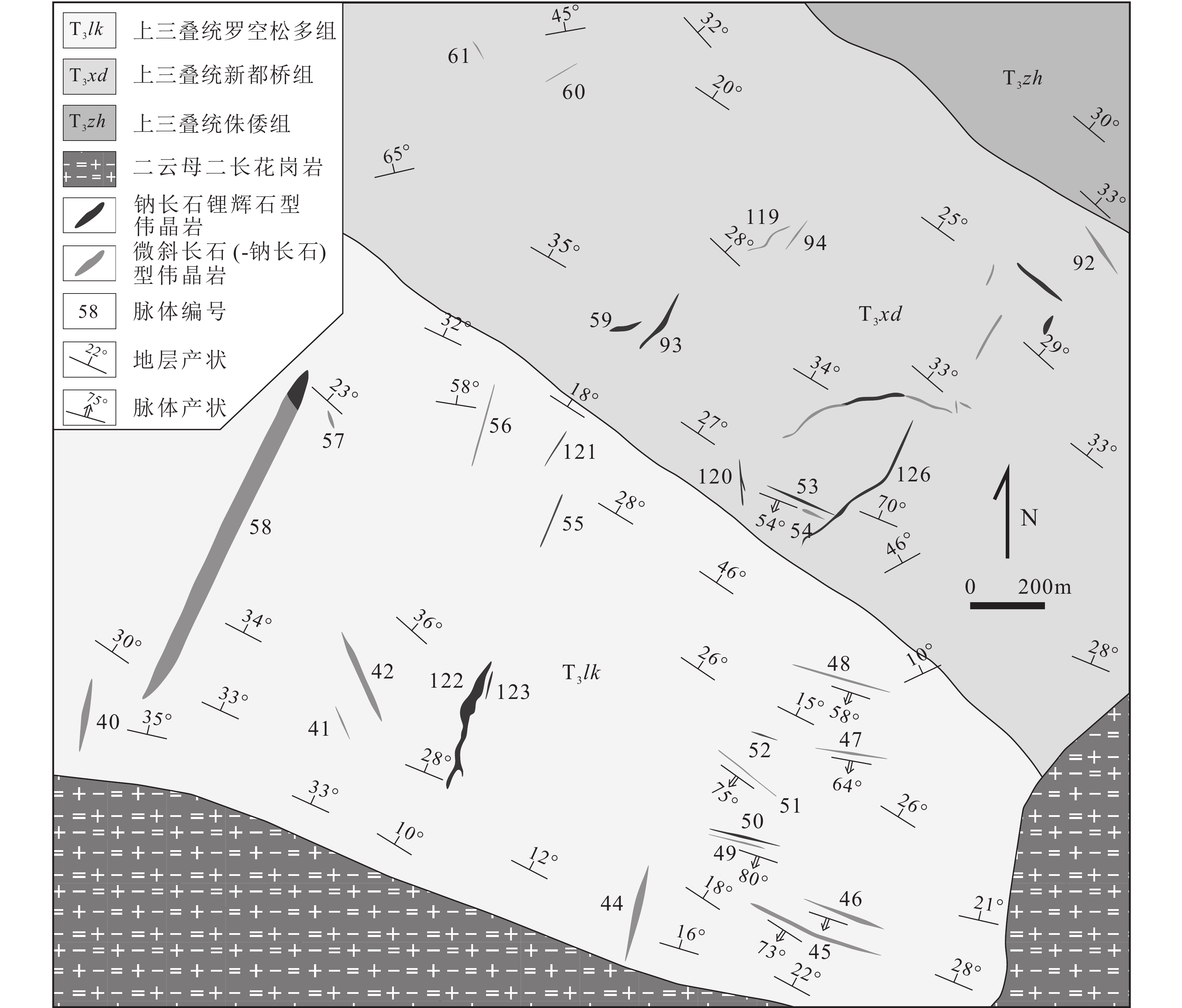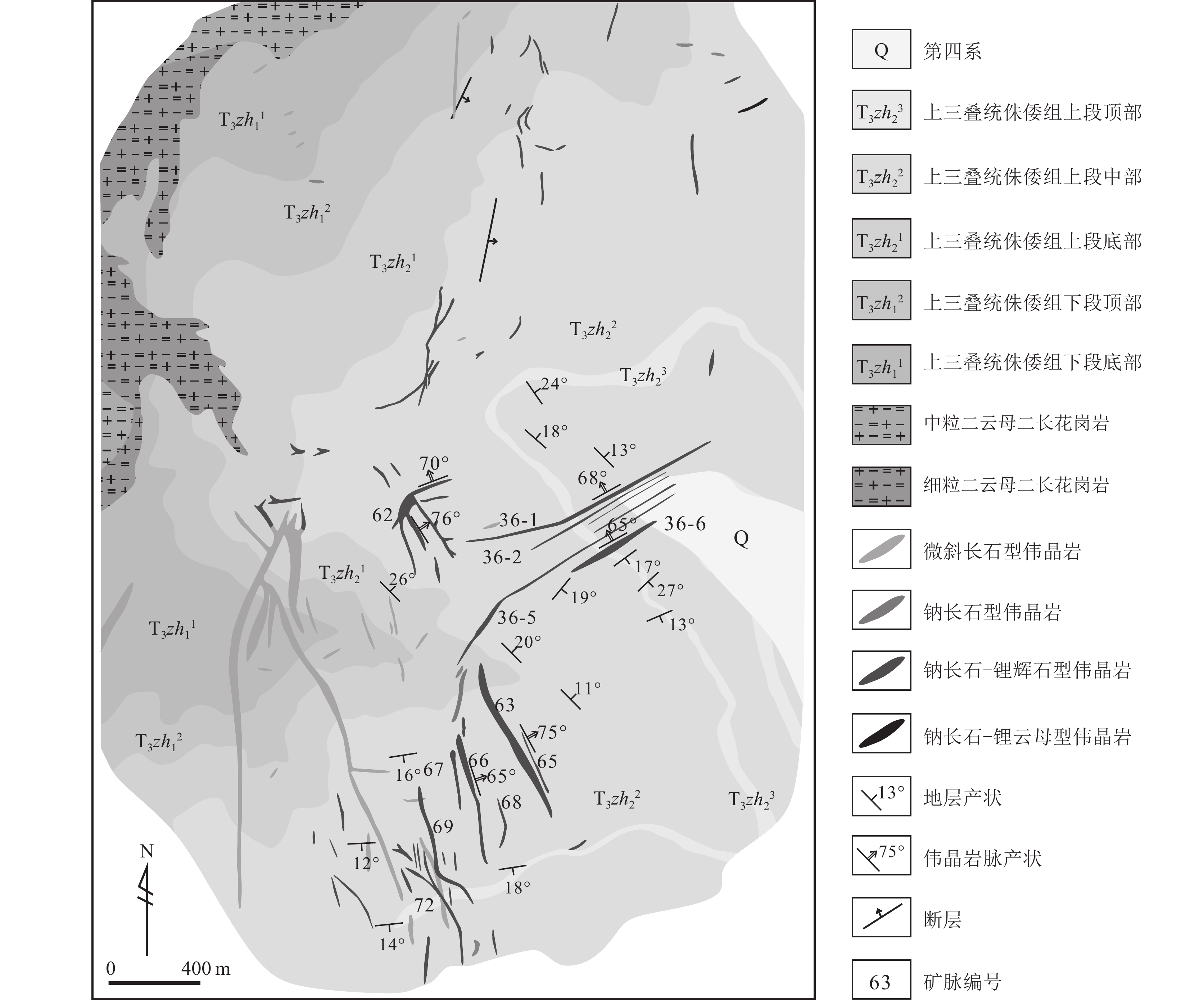Exploration of the relationship between dome structure and the formation of pegmatite lithium deposits: A case study of the Ke’eryin rare metal ore field
-
摘要:研究目的
四川可尔因稀有金属矿田是松潘-甘孜造山带内最重要的伟晶岩型锂矿密集区之一,产于马尔康穹隆中。目前对该穹隆构造如何控制伟晶岩(矿)脉产出尚不清楚,一定程度上限制了对该地区矿体赋存规律的理解。本文探讨可尔因矿田穹隆构造与伟晶岩型锂矿的形成关系,进而指导该地区伟晶岩型锂矿勘查。
研究方法对可尔因地区穹隆构造与典型矿床伟晶岩脉产出特征开展了深入的野外地质调查与构造解析。
研究结果对穹隆构造变形特征的调查结果显示,可尔因地区穹隆构造主要包含4期变形:第一期为早期区域收缩变形,第二期为可尔因韧性拆离带的发育,第三期为顶面向外滑脱+张性破裂的发育,第四期为后期叠加变形。对伟晶岩脉产出特征的分析显示,典型矿床伟晶岩脉的产出可能与下部隐伏岩体的抬升有关,而非简单受控于穹隆核部主岩体部分。
结论结合区域构造演化资料分析认为,上述穹隆变形的第一期与造山早期双向挤压碰撞有关,第二期韧性拆离带的发展是引发可尔因穹隆核部抬升的重要因素,第三期变形中张性破裂是该地区伟晶岩矿脉的主要容矿构造,第四期变形中新生代逆冲断层的发育使得矿田东南部穹隆幔部得以保存,其中的大型—超大型锂矿床受较低程度的构造剥蚀。整个可尔因矿田花岗岩和上覆三叠系可视作主穹隆系统,而局部隐伏花岗岩株和上覆地层可视作子穹隆系统,区内典型锂矿床中伟晶岩(矿)脉的产出受控于子穹隆系统。根据穹隆控矿的特征,指出核部物质来源、幔部容矿空间及伟晶岩空间分带效应是影响并控制可尔因地区穹隆成矿系统的3个重要因素,针对伟晶岩型锂矿的地质找矿尤其要注意梳理子穹隆系统的上述三要素。上述创新思路已在四川加达、高壤等矿床(区)找矿中成功应用,为在以深切割、厚覆盖为特征的高原地区进一步提升伟晶岩型锂矿找矿效率提供了参考依据。
Abstract:ObjectiveThe Ke’eryin lithium ore field in Sichuan is one of the most significant pegmatite−type lithium mineralization zones within the Songpan−Ganzi orogenic belt, situated within the Markam dome. However, the tectonic control exerted by this dome on the emplacement of pegmatite (ore) veins remains unclear, which somewhat limits understanding of the ore−hosting patterns in this region. This paper aims to explore the relationship between the dome structure in the Ke’eryin ore field and the formation of pegmatite−type lithium deposits, providing guidance for the exploration of pegmatite−type lithium resources in the region.
MethodsComprehensive field geological investigations and structural analyses were conducted to examine the dome structure and the distribution characteristics of pegmatite veins in typical deposits in the Ke'eryin area.
ResultsThe investigation into the deformation characteristics of the dome structure reveals that the dome has underwent four phases of deformation. The first phase is early regional contractional deformation. The second phase involves the development of the Ke'eryin ductile detachment zone. The third phase includes the formation of outward−slipping detachments and tensional fractures, and the fourth stage represents late superimposed deformation. Analysis of the occurrence characteristics of pegmatite veins indicates that the distribution of these veins in typical deposit is likely related to the uplift of concealed bodies rather than the outcropped portions of the dome core.
ConclusionsBased on regional tectonic evolution, it is suggested that the first stage of dome deformation is related to bi−directional compressional collision during the early orogenic stage, while the development of the detachment zone in the second stage was a key factor in uplifting the dome core. The tensional fractures formed during the third stage serve as the primary ore−hosting structures for the pegmatite veins in this region. In the fourth stage, the development of Cenozoic thrust faults preserved the mantle of the dome in the southeastern part of the ore field, protecting large to super−large lithium deposits from significant denudation. The granite and overlying Triassic strata in the Ke'eryin ore field can be regarded as the main dome system, while locally concealed granite stocks and overlying strata form sub−dome systems that controled the occurrence of pegmatite (ore) veins in typical lithium deposits. Based on the ore−controlling characteristics of domes, this paper further points out that the core material source, the ore−hosting space in the mantle, and the spatial zoning effect of pegmatites are the three key factors influencing and controlling the dome mineralization system in the Ke'eryin area. For the geological exploration of pegmatite−type lithium deposits, it is particularly important to identify and analyze these three elements within sub−dome systems. The above innovative ideas have been successfully applied and demonstrated in lithium deposits (areas) such as Jiada, and Gaorang, providing a reference for further improving the exploration efficiency of pegmatite type lithium resources in plateau areas characterized by deep cutting and thick coverage.
-
Keywords:
- dome structure /
- pegmatites /
- lithium ore /
- Ke’eryin ore field /
- Songpan-Ganzi orogenic belt
创新点穹隆核部抬升形成的张裂隙是可尔因矿田伟晶岩型锂矿床的主要赋矿空间;局部隐伏的花岗岩株和上覆地层可组成子穹隆系统,控制典型矿床中伟晶岩(矿)脉的产出。
-
铍(Be)是一种关键金属(Freiman, 2008; Foley et al., 2017; 李建康等, 2017),广泛应用于原子能、火箭、导弹、航空航天、冶金等战略性新兴行业(Taylor et al., 2003; Tomberlin, 2004; Snead et al., 2005; Rohe et al., 2011; 王仁财等, 2014; Foley et al., 2017,蒋少涌等,2019;李文昌等,2022)。目前铍资源主要来源于火山岩型铍矿(Lederer et al., 2016),然而随着战略性新兴产业对铍需求的爆发式增长(王伟, 2014; 梁飞等, 2018),铍资源的勘查与找矿已成为中国新一轮找矿突破战略行动的重要任务之一。华南作为中国重要的战略关键金属矿产的主要产区,孕育着大量的稀有金属矿产和非金属矿产(Mao et al., 2013)。东南沿海火山-侵入杂岩发育区的铍矿化强烈,具有良好的铍成矿潜力(饶灿等,2022)。近期,笔者在浙西北常山地区进行了铍矿调查与找矿,取得突破性进展。本文报道了浙西北常山地区铍矿的地质特征和矿物地球化学特征,以期为区域铍资源找矿勘查与指导找矿提供重要支撑。
1. 区域及矿床地质特征
浙西北常山地区位于下扬子岩浆弧常山-桐庐俯冲型火山-侵入岩带,淳安-新登俯冲型火山-侵入岩带南西部,萧山-球川大断裂北西侧。区域内除三叠系、白垩系等缺失外,新元古界—第四系均有出露。区内最古老的地层为新元古界,包括骆家门组、虹赤村组和上墅组,经后期动力变质作用形成了片理化砂岩、片理化泥岩、绿片岩、糜棱岩等;同时出露南华系休宁组浅海相碎屑岩(砾岩、砂砾岩、含砾砂岩、粉砂岩),寒武系海相硅质岩和碳酸盐岩(荷塘组含炭质页岩、灰岩、泥灰岩,大陈岭组白云质灰岩、白云岩,杨柳岗组含炭硅质页岩、泥灰岩,华严寺组条带状灰岩,西阳山组泥灰岩、瘤状灰岩等);奥陶系出露以页岩、砂岩、泥岩为主的台地-盆地相沉积相;志留系、泥盆系、石炭系主要出露浅海—陆相碎屑岩沉积相、滨海—陆源相石英质陆源碎屑沉积相和滨海—浅海相碎屑岩和碳酸盐岩沉积相;侏罗系出露一套较稳定型陆源碎屑沉积相和火山岩(刘道荣等,2012)。
常山地区受晋宁、加里东、华力西、燕山等构造旋回影响,形成以北东向、北北东向为主的构造格架。其基底构造格架控制了本区的沉积建造和地层展布、岩体侵入、火山喷发、中生代构造盆地和各类构造的发育及各类矿产的赋存。区内发育晋宁和燕山旋回火山活动,以喷溢、爆发、间歇性爆发、沉积相间进行,相间出露流纹(斑)岩、火山碎屑岩及火山碎屑沉积岩。岩浆侵入活动以燕山早期和晚期最强,以中酸性侵入岩为主,有少量中基性—酸性岩脉出露。岩性主要为黑云母二长花岗岩、花岗斑岩、辉绿玢岩、闪长玢岩、煌斑岩等。区内发育岩前、芙蓉、大源3个小岩体,属于中浅成岩体,呈岩株和岩枝产出,围岩蚀变较强。出露的矿产主要有钨锡矿、钒矿、银铅锌矿、铍锡矿、煤矿、叶蜡石矿、萤石矿等。
近年来,在常山地区发现了高坞山-蕉坑坞大型萤石矿床(图1)。前人对该地区萤石矿的地质特征、成矿规律及成矿机制进行了详细研究(刘道荣等,2012;古立峰,2013;刘道荣,2013)。目前,2个萤石矿均处于开采状态。该2个矿床位于区内岩前短轴背斜南东翼,受后期构造作用影响,形成一系列断裂和层间破碎带构造。矿区断裂构造发育,呈多期次、多方向展布,走向大致为北东—北东东向、北北东向、北西向和近南北向,其中北东—北东东向、北北东向断裂与萤石成矿关系最密切。岩前岩体是矿区最大的侵入岩,为中细粒黑云母二长花岗岩,其全岩Rb−Sr等时线年龄为124 Ma(韩文彬等,1991)。矿区岩脉发育,岩前岩体北东端和南、北接触带零星出露细粒花岗岩岩脉,高坞山沿北北东走向发育十余条花岗斑岩脉,蕉坑坞也发育少量花岗斑岩脉和辉绿玢岩,而长石岩脉主要分布于萤石矿体周围。在岩前花岗岩周围,热液蚀变强烈,由内向外主要发生矽卡岩化、角岩化、硅化、绢云母化、绿泥石化、萤石化及钾化。前人虽对部分钻孔样品和矿石化学进行过全岩分析,并显示出较高的铍地球化学异常(刘道荣等,2012),但铍的赋存形式和矿化规模尚不清楚。本次通过系统的野外地质调查,结合岩石学、矿物学和地球化学分析,发现高坞山-蕉坑坞大型萤石矿床中出现极高的铍地球化学异常,发育大量铍独立矿物,查明了铍赋存形式,可为常山地区铍矿开采提供理论和技术支持。
![]() 图 1 浙西北高坞山—蕉坑坞地区地质简图 (据刘道荣等,2013修改)Figure 1. Geological map of Gaowushan-Jiaokengwu area in Northwest Zhejiang
图 1 浙西北高坞山—蕉坑坞地区地质简图 (据刘道荣等,2013修改)Figure 1. Geological map of Gaowushan-Jiaokengwu area in Northwest Zhejiang2. 样品与分析方法
本次研究样品采自高坞山-蕉坑坞大型萤石矿体及其围岩。在高坞山萤石矿740 m、695 m、645 m、595 m、545 m、490 m、400 m等不同标高进行样品采集(图2−a);在蕉坑坞萤石矿中,主要采集330 m和290 m标高的萤石围岩样品(图2−b)。对不同标高均进行了系统观察,沿萤石矿体延伸方向,每100 m进行一次系统采样,确保样品具有代表性。全岩主量和微量元素分析在广州澳实分析检测中心完成。研究样品经过烘干破碎至1~2 mm,缩分至250~300 g,然后将样品碾磨至200目。称取3份试样用于主量元素分析:一份用于高氯酸、硝酸、氢氟酸和盐酸消解后蒸干,再用稀盐酸溶解定容制样;一份烘干后,精确称量后置入铂金坩锅,加入四硼酸锂、偏硼酸锂和硝酸锂混合熔剂充分搅拌,再利用熔样机熔融到1050℃后倒入铂金模,冷却制成熔片;另一份精确称重后置入马弗炉进行有氧灼烧至1000℃,冷却后再称重,用于计算样品的烧失量。微量元素分析称取2份试样,分别用于高氯酸、硝酸、氢氟酸消解和加入偏硼酸锂/四硼酸锂熔剂制备样品。全岩的主量元素分析仪器为PANalytical PW2424型X射线荧光光谱仪,其微量和稀土元素分析仪器分别为Agilent 5100和7900 电感耦合等离子体发射光谱与质谱,测试误差均在10%以内。
![]() 图 2 高坞山萤石矿矿体剖面图(a)和蕉坑坞萤石矿矿体剖面图(b) (据刘道荣等,2013修改;其中星号为采样点)Q—第四系;O1y—下奥陶统印渚埠组;∈3x—上寒武统西阳山组;∈3h—上寒武统华严寺组;∈2y—中寒武统杨柳岗组Figure 2. Profile of Gaowushan fluorite deposit(a) and Jiaokengwu fluorite deposit (b)
图 2 高坞山萤石矿矿体剖面图(a)和蕉坑坞萤石矿矿体剖面图(b) (据刘道荣等,2013修改;其中星号为采样点)Q—第四系;O1y—下奥陶统印渚埠组;∈3x—上寒武统西阳山组;∈3h—上寒武统华严寺组;∈2y—中寒武统杨柳岗组Figure 2. Profile of Gaowushan fluorite deposit(a) and Jiaokengwu fluorite deposit (b)铍矿物的原位定量化学成分分析在浙江大学地球科学学院电子探针实验室完成,电子探针型号为EPMA-1720H。定量分析条件为:电压12 kV、硅铍石和羟硅铍石的分析电流分别为200 nA和50 nA,束斑为1μm,Be元素的特征峰测试时间为100 s,背景测试时间为50 s,其他元素特征峰测试时间为20 s,背景测试时间为10 s。硅铍石和羟硅铍石的电子探针分析标样为:福建南平伟晶岩硅铍石(SiKα、BeKα)、硅锌矿 (MnKα)、钾长石(AlKα和KKα)、斜长石(NaKα)、铁铝榴石(CaKα和FeKα)、镁铝榴石(MgKα),所有数据均进行了ZAF3处理。
3. 铍矿化特征
高坞山-蕉坑坞大型萤石矿床产于花岗岩体与围岩接触面及其附近外接触带、花岗岩围岩的层间破碎带及构造破碎带。与花岗岩接触部位,矽卡岩化较强烈,围岩出现各种热液蚀变现象,如角岩化、硅化、大理岩化、绢云母化、绿泥石化、萤石矿化、钾长石化等。花岗岩围岩主要为寒武系华严寺组和杨柳岗组灰岩;层间破碎带分布于华严寺组和西阳山组灰岩中;构造破碎带通常垂直或斜向切穿杨柳岗组、华严寺组和西阳山组。萤石矿体主要受构造控制,多赋存于北北东向构造带中,矿体走向最长450 m,最大倾斜延深约550 m。在高坞山和蕉坑坞萤石矿深部均可见花岗岩(图3−a),花岗岩的围岩绝大部分已经蚀变,形成层状和似层状蚀变岩,但仍保留灰岩的条带结构(图3−b~d),同时可见花岗斑岩(图3−e),受构造断裂作用,大量萤石脉和方解石脉穿插于蚀变灰岩中(图3−f, g)。
通过对高坞山和蕉坑坞萤石矿矿区进行野外考察,采集不同标高不同蚀变类型的萤石矿体围岩样品。样品的全岩及Be化学全分析结果表明(表1),铍矿化主要发育于萤石矿体与围岩的接触带,不同标高(740 m、695 m、645 m、595 m、545 m、490 m、400 m)萤石矿体围岩均有不同程度Be富集。高坞山萤石矿区Be含量达4400×10−6,而蕉坑坞萤石矿区为1300×10−6。
表 1 浙西北高坞山和蕉坑坞萤石矿围岩主量元素及Be含量Table 1. The whole rock major elements and beryllium content of host rocks of Gaowushan and Jiaokengwu fluorite deposit in Northwest Zhejiang Province样品号 SiO2 Al2O3 CaO TFe2O3 MgO MnO BaO K2O Na2O P2O5 SnO2 SO3 TiO2 F 烧失量 Be/10−6 GWS 740-1 57.62 11.88 10.65 2.67 1.75 0.04 0.10 6.99 0.99 0.04 <0.01 <0.01 0.33 6.2 4.35 305 GWS 740-2 55.67 10.52 13.90 2.28 1.82 0.03 0.09 5.70 0.06 0.07 0.01 0.04 0.28 6.2 6.77 550 GWS 740-3 42.29 12.33 21.1 2.51 2.23 0.04 0.05 5.52 2.29 0.03 0.02 <0.01 0.40 12.9 4.06 148.5 GWS 740-4 52.44 9.47 14.80 3.12 3.93 0.07 <0.01 5.02 0.75 <0.01 0.01 0.05 0.22 8.0 6.43 31.8 GWS 740-5 37.13 10.62 28.7 2.08 1.85 0.03 0.02 2.36 3.50 0.01 0.02 <0.01 0.21 17.2 4.45 146.0 GWS 695 35.38 10.26 23.0 4.19 4.10 0.09 0.16 4.65 0.48 0.07 0.01 0.09 0.40 5.5 14.52 117.5 GWS 645-1 43.21 11.77 21.8 1.34 1.22 0.04 0.06 9.28 0.13 <0.01 0.02 <0.01 0.05 13.2 4.22 4400 GWS 645-2 71.10 14.42 0.17 0.63 0.97 0.02 0.22 9.97 0.09 0.01 <0.01 <0.01 0.11 0.1 1.43 1100 GWS 645-3 34.02 10.74 28.2 3.32 2.42 0.06 0.05 6.48 0.10 0.01 0.03 0.93 0.19 16.5 5.40 589 GWS 595-1 71.89 14.50 0.48 1.78 0.03 0.08 0.01 4.84 4.32 <0.01 <0.01 0.08 0.01 0.8 0.97 18.60 GWS 545-1 12.90 3.81 56.5 0.57 1.40 0.02 0.06 2.25 0.07 <0.01 0.05 0.01 0.05 33.7 2.54 85.8 GWS 545-2 16.40 6.96 45.0 1.86 6.32 0.05 0.15 2.58 0.07 0.07 0.05 0.02 0.28 27.9 3.94 1300 GWS 490-2 73.74 12.14 0.85 2.52 0.09 0.03 0.01 5.62 2.90 0.01 <0.01 0.03 0.17 0.4 1.01 19.60 GWS 400-1 9.81 2.65 43.2 1.15 5.92 0.04 0.07 1.44 0.03 0.01 0.02 0.39 0.10 0.6 35.42 15.75 JKW 330-3 28.47 7.46 25.9 22.98 4.82 0.46 0.05 1.16 0.68 0.07 0.23 0.04 0.05 8.6 3.07 168.0 JKW-1 20.47 2.54 53.2 0.61 0.70 0.01 0.04 1.69 0.05 0.02 0.04 <0.01 0.01 31.8 2.90 73.5 JKW-3 26.06 4.70 43.9 1.09 2.92 0.02 0.05 3.73 0.05 0.01 0.03 <0.01 0.08 25.7 3.19 1300 注:主量元素含量单位为% 室内显微镜观察与电子探针分析结果表明,高坞山和蕉坑坞萤石矿中铍矿物主要为硅铍石和羟硅铍石,它们常与萤石、钾长石、石英、方解石等矿物形成矿物组合(图版Ⅰ)。硅铍石晶体大小可达到厘米级。较大的硅铍石晶体通常晶形较好(图版Ⅰ−a,b),少量硅铍石包裹于萤石中,部分已转变为羟硅铍石(图版Ⅰ−c)。硅铍石常与钾长石、萤石、方解石形成矿物组合(图版Ⅰ−d),少量大颗粒硅铍石晶体与钾长石紧密共生(图版Ⅰ−e)。在以钾长石为主的矿物裂隙中,可见硅铍石与萤石形成的细脉(图版Ⅰ−f),也可见钾长石与硅铍石、方解石形成的细脉(图版Ⅰ−g)。羟硅铍石主要分布于钾长石与石英、萤石晶间(图版Ⅰ−h),少量羟硅铍石分布于钾长石裂隙中,其形成与钾长石的热液蚀变有关(图版Ⅰ−i)。电子探针化学成分分析结果表明,高坞山与蕉坑坞萤石矿中,硅铍石和羟硅铍石的化学成分均相似,硅铍石含53.69% ~ 56.52% SiO2,42.45% ~ 46.12% BeO,同时还含少量MnO、MgO、Al2O3、FeO等,其含量不超过0.5%;羟硅铍石含48.79% ~ 53.46% SiO2、40.13% ~ 43.93% BeO,Al2O3含量最高可达0.45%,同时含少量MnO、MgO、FeO等,不含F或F含量低于检测限。
4. 矿床成因与发现意义
Be在流体中表现为双性元素的地球化学行为,在酸性流体或热液中,Be以阳离子形式存在,在碱性流体或热液中,Be常与碱金属或碱土金属元素结合,以络阴离子形式存在(Černý, 2002)。鉴于此,Be在岩浆-热液过程中均可以得到富集甚至成矿,在变质作用过程中也可得到超常富集。在岩浆-热液过程中Be得到超常富集,可以形成火山岩型铍矿、花岗岩型铍矿、伟晶岩型铍矿、碱性岩型铍矿、矽卡岩型铍矿等(Barton et al., 2002)。目前,火山岩型铍矿是国际铍资源的主要来源(Lederer et al., 2016),其成矿机制主要为含Be凝灰岩或流纹岩经过热液蚀变,Be获得超常富集并成矿(Wood, 1992; Foley et al., 2012),羟硅铍石和硅铍石是火山岩型铍矿主要的矿石矿物(Lederer et al., 2016; Foley et al., 2017)。
花岗斑岩、花岗岩等侵入岩在形成和演化过程中,与碳酸盐岩围岩反应通常会形成一系列蚀变岩或矽卡岩。这些接触变质或热液蚀变过程也会导致Be富集成矿(Barton et al., 2002),如在湘南地区香花岭矽卡岩(黄蕴慧等,1988;赵一鸣等,2017)、香花铺矽卡岩、界牌岭矽卡岩(唐朝永等,2010)中,Be均得到不同程度地富集,形成硅铍石、羟硅铍石、锂铍石、香花石、孟宪民石等铍矿物。俄罗斯西部Transbaikalia地区也发育典型的矽卡岩型铍矿床(Lykhin et al., 2014; Damdinova et al., 2019)。然而,矽卡岩型铍矿床极少作为铍矿开采。
与典型矽卡岩型铍矿相比,高坞山和蕉坑坞铍矿具有如下显著特征:①矿山正在进行萤石矿开采,极易弄清楚铍矿的分布;②矽卡岩化较弱,符山石、钙铝榴石等矽卡岩矿物占比较小,更多出现角岩化、硅化、绿泥石化和萤石化;③铍矿分布在萤石矿体与围岩接触带,Be的超常富集与萤石化、钾长石化、碳酸盐化相关;④铍矿石矿物为硅铍石和羟硅铍石(图版Ⅰ),铍矿物种较单一,未出现矽卡岩型铍矿中复杂且铍矿物种较多的情况。该矿床受岩前岩体岩浆侵入作用、构造活动及碳酸盐岩地层控制,岩体侵位过程中高F热液作用是Be超常富集的核心控制因素。刘道荣(2013) 认为,高坞山-蕉坑坞萤石矿属于中低温热液矿床,受岩前岩体、构造、地层3个因素共同控制,成矿作用以充填为主,伴有交代作用。但常山地区的萤石矿又与传统花岗岩周围萤石矿有一定区别,出现了较弱的矽卡岩化。同样,高坞山和蕉坑坞地区Be的富集也与花岗岩和围岩相关,Be的富集是岩前花岗岩岩浆和热液与围岩发生反应所致,属于热液型铍矿床。地球化学分析结果表明,岩前黑云母二长花岗岩含17×10−6 Be,周围的花岗斑岩脉含Be 15×10−6,而煌斑岩岩脉Be的含量达115×10−6 (郑兴泉等,1990;古立峰,2013)。常山地区泥质灰岩可含40×10−6 Be,黄铁矿化角岩可含105×10−6 Be (李良传等,2017)。高坞山和蕉坑坞萤石矿具有强烈的铍矿化,部分矿化点可达4400×10−6 和1300×10−6 Be (表1),萤石矿石可含390×10−6 Be (刘道荣等,2012;刘道荣,2013)。这些特征显示,高坞山和蕉坑坞地区铍成矿潜力巨大,具有丰富的铍资源。
鉴于正在开采的高坞山和蕉坑坞大型萤石矿床中发现了铍矿化,将有助于矿山综合利用,合理开发萤石资源和铍资源。硅铍石和羟硅铍石作为铍矿石矿物,更有利于选冶。除高坞山和蕉坑坞外,在常山地区毛良坞—姜家、蚵蚾坞、严家—瑶岭、八面山—丁家与修书一带均发现了Be的土壤地球化学异常(李良传等,2017)。这些特征显示,常山地区具有较大的铍资源潜力,在今后勘查和找矿过程中应予以格外重视。
-
图 1 松潘-甘孜造山带构造格架(a,据Roger et al., 2004; Xu et al., 2020修改)与可尔因锂矿田地质简图(b, 据Dai et al., 2021修改;矿田东部南部逆冲断层KEYT与韧性拆离带KDZ据Zheng et al., 2020)
1—三叠系西康群复理石沉积岩;2—扬子西缘新元古代−古生代地层;3—伟晶岩型锂矿田;4—缝合带;5—逆冲断层;6—走滑断层;SGOB—松潘甘孜造山带;NCB—华北克拉通;EKL-QDM-QL—东昆仑-柴达木-祁连地块;QT-CD—羌塘-昌都地块;WKL—西昆仑地块;YZB—扬子板块;EKL-ANMQS—东昆仑-阿尼玛卿缝合带;NQLT—北祁连断裂;LMST—龙门山断裂;JSSZ—金沙江缝合带;XSHF—鲜水河断裂;KEYT—可尔因逆冲断层;极射赤平投影内容为层理产状
Figure 1. Sketch map of regional tectonics (a) and simplified geological map of the Ke’eryin ore field (b)
图 5 李家沟矿床地质简图(据邓运等,2018)
Q—第四系;T3zh5—上三叠统侏倭组第五段;T3zh4—上三叠统侏倭组第四段;T3zh3—上三叠统侏倭组第三段;T3zh2—上三叠统侏倭组第二段;T3zh1—上三叠统侏倭组第一段
Figure 5. Schematic geological map of the Lijiagou deposit
图 7 可尔因矿田东部穹隆构造与伟晶岩型锂矿床形成关系示意图(剖面图)(剖面位置见图1;该剖面地形参考实际地形,比例不代表实际比例)
Figure 7. Schematic diagram illustrating the relationship between dome structures and the formation of pegmatite type lithium deposits in the eastern part of the Ke’eryin ore field
图 8 高壤地区地质简图(据中国地质科学院矿产资源研究所,2022)
Figure 8. Schematic geological map of the Gaorang area
图 9 加达矿床地质简图(据Li et al., 2024a)
Figure 9. Schematic geological map of the Jiada deposit
-
Bureau of Geology and Mineral Resources of Sichuan Province. 1991. Regional geology of Sichuan Province[M]. Beijing: Geological Publishing House: 1−732 (in Chinese).
Dai H Z, Wang D H, Liu S B, et al. 2021. Newly discovered euxenite and Polycrase in the Jiada pegmatite−type lithium deposit, Ke’eryin lithium ore field, and its geological significance[J]. Acta Geologica Sinica (English Edition), 95(5): 1782−1783. doi: 10.1111/1755-6724.14756
de Sigoyer J, Vanderhaeghe O, Duchêne S, et al. 2014. Generation and emplacement of Triassic granitoids within the Songpan Ganze accretionary−orogenic wedge in a context of slab retreat accommodated by tear faulting, Eastern Tibetan plateau, China[J]. Journal of Asian Earth Sciences, 88: 192−216. doi: 10.1016/j.jseaes.2014.01.010
Deng Y, Fei G C, Li J, et al. 2018. Study of C−HO isotopes and geochronology of the Lijiagou pegmatite spodumene deposit in Sichuan Province[J]. Mineralogy and Petrology, 38(3): 40−47 (in Chinese with English abstract).
Deschamps F, Duchêne S, de Sigoyer J, et al. 2017. Coeval mantle−derived and crust − derived magmas forming two neighbouring plutons in the Songpan Garze accretionary orogenic wedge (SW China)[J]. Journal of Petrology, 58: 2221−2256. doi: 10.1093/petrology/egy007
Dong Y P, Santosh M. 2016. Tectonic architecture and multiple orogeny of the Qinling Orogenic Belt, Central China[J]. Gondwana Research, 29: 1−40. doi: 10.1016/j.gr.2015.06.009
Fei G C, Li T R, Menuge J F, et al. 2023. Petrogenesis of aplites in the Ke'eryin rare metal orefield in the Songpan−Garze Fold Belt, Eastern Tibet: Evidence from mineralogy, geochemistry, geochronology and Hf−Nd isotopes[J]. Lithos, 438/439: 107017.
Geochemical Exploration Team of Sichuan Bureau of Geology and Mineral Resources. 2022. Lithium exploration and resource reserve verification report of Dangba mining area, Markam City, Sichuan Province[R]. 1−165 (in Chinese).
Gu C H. 2014. Metallogenic regularity of spodumene deposits in the closely spaced pegmatite area in the southeastern Ke’eryin pegmatite field, Sichuan province[J]. Contributions to Geology and Mineral Resources Research, 29(1): 59−65 (in Chinese with English abstract).
Guo X, Gao R, Randy Keller G, et al. 2013. Imaging the crustal structure beneath the eastern Tibetan Plateau and implications for the uplift of the Longmen Shan range[J]. Earth and Planetary Science Letters, 379: 72−80. doi: 10.1016/j.jpgl.2013.08.005
Harrowfield M J, Wilson J L. 2005. Indosinian deformation of the Songpan Garze Fold Belt, northeast Tibetan Plateau[J]. Journal of Structural Geology, 27: 101−117. doi: 10.1016/j.jsg.2004.06.010
Institute of Mineral Resources (IMR), Chinese Academy of Geological Sciences (CAGS). 2022. Report on the results of the second−level project of comprehensive investigation and evaluation of large lithium−beryllium polymetallic resource base in Songpan−Ganzi lithium metallogenic belt[R]. 1−337 (in Chinese).
Li J K, Li P, Yan Q G, et al. 2023. Geology and mineralization of the Songpan−Ganze−West Kunlun pegmatite−type rare−metal metallogenic belt in China: An overview and synthesis[J]. Science China Earth Sciences, 66(8): 1702−1724 (in Chinese with English abstract). doi: 10.1007/s11430-022-1084-x
Li J K. 2006. Mineralizing mechanism and continental geodynamics of typical pegmatite deposits in western Sichuan, China[D]. Doctoral Dissertation of China University of Geosciences (Beijing): 1−226 (in Chinese with English abstract).
Li J K, Wang D H, Fu X F. 2006. 40Ar/39Ar ages of the Keeryin pegmatite type rare metal deposit, WesternSichuan, and its tectonic significances[J]. Acta Geologica Sinica, 80(6): 843−848 (in Chinese with English abstract).
Li S, Miller C F, Wang T, et al. 2021. Role of sediment in generating contemporaneous, diverse “type” granitoid magmas[J]. Geology, 50: 427−431.
Li X, Dai H Z, Huang F, et al. 2024a. Genesis of the Jiada pegmatite lithium deposit in the Ke'eryin ore field, Western Sichuan, China: Evidence from whole−rock trace element and Li isotope[J]. Ore Geology Reviews, 170: 106106. doi: 10.1016/j.oregeorev.2024.106106
Li X, Dai H Z, Liu S B, et al. 2024b. Genesis of the Ke’eryin two−mica monzogranite in the Ke’eryin pegmatite−type lithium ore field, Songpan−Garze Orogenic Belt: Evidence from lithium isotopes[J]. Minerals, 14: 687.
Li X, Dai H Z, Wang D H, et al. 2024c. Metallogenic regularity and exploration of the Ke’eryin lithium ore field in Aba, Sichuan[J]. Acta Petrologica Sinica, 40(9): 2819−2840 (in Chinese with English abstract).
Li X, Dai H Z, Wang D H, Liu S B, et al. 2022. Geochronological and geochemical constraints on magmatic evolution and mineralization of the northeast Ke’eryin pluton and the newly discovered Jiada pegmatite−type lithium deposit, Western China[J]. Ore Geology Reviews, 150: 105164. doi: 10.1016/j.oregeorev.2022.105164
Lowenstern J B. 1995. Intrusive degassing at the magma/wall rock interface[C]//Brown M, Picolli P M. The Origin of Granites and Related Rocks. Third Hutton Symposium: Abstracts, USGS Circular 1129: 92.
Ma S C, Wang D H, Liu S B, et al. 2020. The application of comprehensive prospecting methods on the hardrock type lithium deposit--A case study of the Jiada lithium mine in the Maerkang rare metals orefield[J]. Acta Geologica Sinica, 94(8): 2341-2353 (in Chinese with English abstract).
Mattauer M, Malavielle J, Calassou S. 1992. La chane triasique de Songpan−Ganze (oust Sichun at east Tibet): une chane de plissment−decollement sur margepassive[J]. ComptesRendus de I’ Acad. Sci. Paris 314 (6): 619−626.
Mulja T, Williams−Jones A E. 2018. The physical and chemical evolution of fluids in rare−element granitic pegmatites associated with the Lacorne pluton, Quebec, Canada[J]. Chemical Geology, 493: 281−297. doi: 10.1016/j.chemgeo.2018.06.004
Nabelek P I, Whittington A G, Sirbescu M L C. 2010. The role of H2O in rapid emplacement and crystallization of granitic pegmatites: Resolving the paradox of large crystals in highly undercooled melts[J]. Contributions to Mineralogy and Petrology, 160: 313−325. doi: 10.1007/s00410-009-0479-1
Roger F, Jolivet M, Malavieille J. 2010. The tectonic evolution of the Songpan−Garze (North Tibet) and adjacent areas from Proterozoic to Present: A synthesis[J]. Journal of Asian Earth Sciences, 39: 254−269. doi: 10.1016/j.jseaes.2010.03.008
Roger F, Malavieille J, Leloup P H, et al. 2004. Timing of granite emplacement and cooling in the Songpan−Garze Fold Belt (eastern Tibetan Plateau) with tectonic implications[J]. Journal of Asian Earth Sciences, 22: 465−481. doi: 10.1016/S1367-9120(03)00089-0
Roger F. 1994. Datations et tracage des granitoides associes a la chainede Songpan − Garze ( Ouest Sichuan , Chine) par les methodes U/Pb, Rb/Sr et Sm/Nd[J]. These de doctorat, Montpellier II: 1−239.
Sengor A M C. 1985. Tectonic subdivisions and evolution of Asia[J]. Bull. Tech. Univ. Istanbul, 46: 355−435.
Shi Z L, Zhang H F, Cai H M. 2009. Petrogenesis of strongly peraluminous granites in Markan area, Songpan Fold Belt and its tectonic implication[J]. Earth Science, 34(4): 569−584 (in Chinese with English abstract).
Sichuan Provincial Bureau of Geology and Mineral Resources. 1991. Regional geology of Sichuan Province[M]. Beijing: Geological Publishing House: 1−732 (in Chinese).
Geological team 404 of Sichuan provincial geological Bureau. 1965. Preliminary survey report on the Kerin granite megalite field in Sichuan Province[R]. National Geological Data Center, DOI:10.35080/n01.c.36860 (in Chinese).
Sirbescu M L C, Schmidt C, Veksler I V, et al. 2017. Experimental crystallization of undercooled felsic liquids: generation of pegmatitic texture[J]. Journal of Petrology, 58: 539−568. doi: 10.1093/petrology/egx027
Wang D H, Dai H Z, Liu S B, et al. 2022. New progress and trend in ten aspects of lithium exploration practice and theoretical research in China in the past decade[J]. Journal of Geomechanics, 28(5): 743−764 (in Chinese with English abstract).
Wang D H, Dai H Z, Yu Y, et al. 2021. Theory, method and practice of survey and evaluation of large−scale lithium resource base: A case study of the Jiajika super−large lithium mine in western Sichuan[M]. Beijing: Science Press: 1−458 (in Chinese).
Wang D H, Liu S B, Yu Y, et al. 2019. Exploration progress and development suggestion for the large−scale mining base of strategic critical mineral resources in western Sichuan[J]. Acta Geologica Sinica, 93(6): 1444−1453 (in Chinese with English abstract).
Wang D H, Dai H Z, Sun Y, et al. 2023. Theory and practice of deep exploration of lithium energy metal minerals[M]. Beijing: Geological Publishing House (in Chinese).
Wang D H, Zou T R, Xue Z G, et al. 2004. Advance in the study of using pegmatite deposits as the tracer of orogenic process[J]. Advances in Earth Science, 19(4): 614−620 (in Chinese with English abstract).
Wang Z P, Liu S B, Ma S C, et al. 2018. Metallogenic regularity, deep and periphery prospecting of Dangba superlarge spodumene deposit in Aba, Sichuan Province[J]. Earth Science, 43(6): 2029−2041 (in Chinese with English abstract).
Weislogel A L, Graham S A, Chang E Z, et al. 2010. Detrital zircon provenance from three turbidite depocenters of the Middle−Upper Triassic Songpan−Ganzi complex, central China: Record of collisional tectonics, erosional exhumation, and sediment production[J]. Geological Society of America Bulletin, 122(11/12): 2041−2062. doi: 10.1130/B26606.1
Xiao L, Zhang H F, Clemens J D, et al. 2007. Late Triassic granitoids of the eastern margin of the Tibetan Plateau: Geochronology, petrogenesis and implications for tectonic evolution[J]. Lithos, 96(3/4): 436−452. doi: 10.1016/j.lithos.2006.11.011
Xu Z Q, Fu X F, Ma X X, et al. 2016. The gneiss domes in Tibetan Plateau and their potential for prospecting[J]. Acta Geologica Sinica, 90(11): 2971−2981 (in Chinese with English abstract).
Xu Z Q, Fu X F, Wang R C, et al. 2020. Generation of lithiumbearing pegmatite deposits within the Songpan−Ganze orogenic belt, East Tibet[J]. Lithos, 354−355: 105281. doi: 10.1016/j.lithos.2019.105281
Xu Z Q, Fu X F, Zhao Z B, et al. 2019. Discussion on relationships of gneiss dome and metallogenic regularity of pegmatite type lithium deposits[J]. Earth Science, 44(5): 1452−1463 (in Chinese with English abstract).
Xu Z Q, Hou L W, Wang Z X, et al. 1992. Orogenic process of the Songpan−Ganzi orogenic belt, China[M]. Beijing: Geological Publishing House: 1−202 (in Chinese).
Xu Z Q, Wang R C, Zhao Z B, et al. 2018. On the structural backgrounds of the large−scale "Hard−rock type" lithium ore belts in China[J]. Acta Geologica Sinica, 92(6): 1091−1106 (in Chinese with English abstract).
Yang Y Q, Liu S B, Wang D H, et al. 2023. Discussion on the difference of metallogenic characteristics and genesis of the Jiajika and Keeryin rare metals ore fields in Western Sichuan[J]. Acta Geoscientica Sinica, 44(3): 419−433 (in Chinese with English abstract).
Yin A, Harrison T M. 2000. Geologic evolution of the Himalayane Tibetan orogen[J]. Annual Review of Earth and Planetary Sciences, 28: 211−280. doi: 10.1146/annurev.earth.28.1.211
Yuan C, Zhou M F, Min S, et al. 2010. Triassic granitoids in the eastern Songpan Ganzi Fold Belt, SW China: Magmatic response to geodynamics of the deep lithosphere[J]. Earth and Planetary Science Letters, 290(3/4): 481−492.
Zhang H F, Parrish R, Zhang L, et al. 2007. A−type granite and adakitic magmatism association in Songpan−Garze fold belt, eastern Tibetan Plateau: Implication for lithospheric delamination[J]. Lithos, 97: 323−335. doi: 10.1016/j.lithos.2007.01.002
Zhang H F, Zhang L, Harris N, et al. 2006. U−Pb zircon ages, geochemical and isotopic compositions of granitoids in songpan−garze fold belt, eastern Tibetan plateau: constraints on petrogenesis and tectonic evolution of the basement[J]. Contributions to Mineralogy and Petrology, 152: 75−88. doi: 10.1007/s00410-006-0095-2
Zhao Z B, Du J X, Liang F H, et al. 2019. Structure and metamorphism of Markam gneiss dome from the eastern Tibetan plateau and its implications for crustal thickening, metamorphism, and exhumation[J]. Geochemistry, Geophysics, Geosystems, 20: 24−45.
Zheng Y L, Xu Z Q, Gao W Q, et al. 2020. Tectonic genesis of the Markam gneiss dome and pegmatitic lithium deposits in western Sichuan Province[J]. Acta Geologica Sinica, 95(10): 3069−3084 (in Chinese with English abstract).
Zheng Y L, Xu Z Q, Li G W, et al. 2020. Genesis of the Markam gneiss dome within the Songpan−Garze orogenic belt, eastern Tibetan Plateau[J]. Lithos, 362/363: 105475. doi: 10.1016/j.lithos.2020.105475
Zhu H P, Fei G C, Tan H, et al. 2023. Geological characteristics and metallogenic age of pegmatites in the central zone of the Dangba pegmatite−type rare−metal deposit in the Ke’eryin orefield, Sichuan province[J]. Bulletin of Mineralogy, Petrology and Geochemistry, 42(2): 350−359 (in Chinese with English abstract).
邓运, 费光春, 李剑, 等. 2018. 四川李家沟伟晶岩型锂辉石矿床碳氢氧同位素及成矿时代研究[J]. 矿物岩石, 38(3): 40−47. 古城会. 2014. 四川省可尔因伟晶岩田东南密集区锂辉石矿床成矿规律[J]. 地质找矿论丛, 29(1): 59−65. 李建康, 李鹏, 严清高, 等. 2023. 松潘-甘孜-西昆仑花岗伟晶岩型稀有金属成矿带成矿规律[J]. 中国科学: 地球科学, 53(8): 1718−1740. 李建康. 2006. 川西典型伟晶岩型矿床的形成机理及其大陆动力学背景[D]. 中国地质大学(北京)博士学位论文: 1−226. 李建康, 王登红, 付小方. 2006. 川西可尔因伟晶岩型稀有金属矿床的40Ar/39Ar年代及其构造意义[J]. 地质学报, 80(6): 843−848. 李鑫, 代鸿章, 王登红, 等. 2024. 四川阿坝可尔因锂矿田成矿规律与成矿预测[J]. 岩石学报, 40(9): 2819−2840. 马圣钞, 王登红, 刘善宝, 等. 2020. 综合勘查方法在硬岩型锂矿找矿中的应用——以马尔康稀有金属矿田加达锂矿为例[J]. 地质学报, 94(8): 2341−2353. 时章亮, 张宏飞, 蔡宏明. 2009. 松潘造山带马尔康强过铝质花岗岩的成因及其构造意义[J]. 地球科学, 34(4): 569−584. 四川省地质矿产局. 1991. 四川省区域地质志[M]. 北京: 地质出版社: 1−732. 四川省地质局四〇四地质队. 1965. 四川省可尔因花岗伟晶岩田初步普查报告[R]. 全国地质资料馆, DOI: 10.35080/n01.c.36860. 四川省地质矿产勘查开发局化探队. 2022. 四川省马尔康市党坝矿区锂矿勘探及资源储量核实报告[R]. 1−165. 王登红, 代鸿章, 刘善宝, 等. 2022. 中国锂矿十年来勘查实践和理论研究的十个方面新进展新趋势[J]. 地质力学学报, 28(5): 743−764. 王登红, 代鸿章, 于扬, 等. 2021. 大型锂资源基地调查评价的理论方法与实践以川西甲基卡超大型锂矿为例[M]. 北京: 科学出版社: 1−458. 王登红, 刘善宝, 于扬, 等. 2019. 川西大型战略性新兴产业矿产基地勘查进展及其开发利用研究[J]. 地质学报, 93(6): 1444−1453. 王登红, 代鸿章, 孙艳, 等. 2023. 锂能源金属矿产深部探测理论与实践[M]. 北京: 地质出版社. 王登红, 邹天人, 徐志刚, 等. 2004. 伟晶岩矿床示踪造山过程的研究进展[J]. 地球科学进展, 19(4): 614−620. 王子平, 刘善宝, 马圣钞, 等. 2018. 四川阿坝州党坝超大型锂辉石矿床成矿规律及深部和外围找矿方向[J]. 地球科学, 43(6): 2029−2041. 许志琴, 付小方, 马绪宣, 等. 2016. 青藏高原片麻岩穹窿与找矿前景[J]. 地质学报, 90(11): 2971−2981. 许志琴, 付小方, 赵中宝, 等. 2019. 片麻岩穹窿与伟晶岩型锂矿的成矿规律探讨[J]. 地球科学, 44(5): 1452−1463. 许志琴, 侯立玮, 王宗秀, 等. 1992. 中国松潘-甘孜造山带的造山过程[M]. 北京: 地质出版社: 1−190. 许志琴, 王汝成, 赵中宝, 等. 2018. 试论中国大陆“硬岩型”大型锂矿带的构造背景[J]. 地质学报, 92(6): 1091−1106. 杨岳清, 刘善宝, 王登红, 等. 2023. 川西甲基卡和可尔因矿田稀有金属成矿特征差异性及成因探讨[J]. 地球学报, 44(3): 419−433. 郑艺龙, 许志琴, 高文琦, 等. 2020. 川西马尔康片麻岩穹隆与伟晶岩型锂矿的构造成因[J]. 地质学报, 95(10): 3069−3084. 中国地质科学院矿产资源研究所. 2022. 松潘-甘孜成锂带锂铍多金属大型资源基地综合调查评价二级项目成果报告[R]. 朱汇派, 费光春, 谭华, 等. 2023. 四川可尔因矿田党坝伟晶岩型稀有金属矿床中带伟晶岩地质特征及成矿时代[J]. 矿物岩石地球化学通报, 42(2): 350−359.



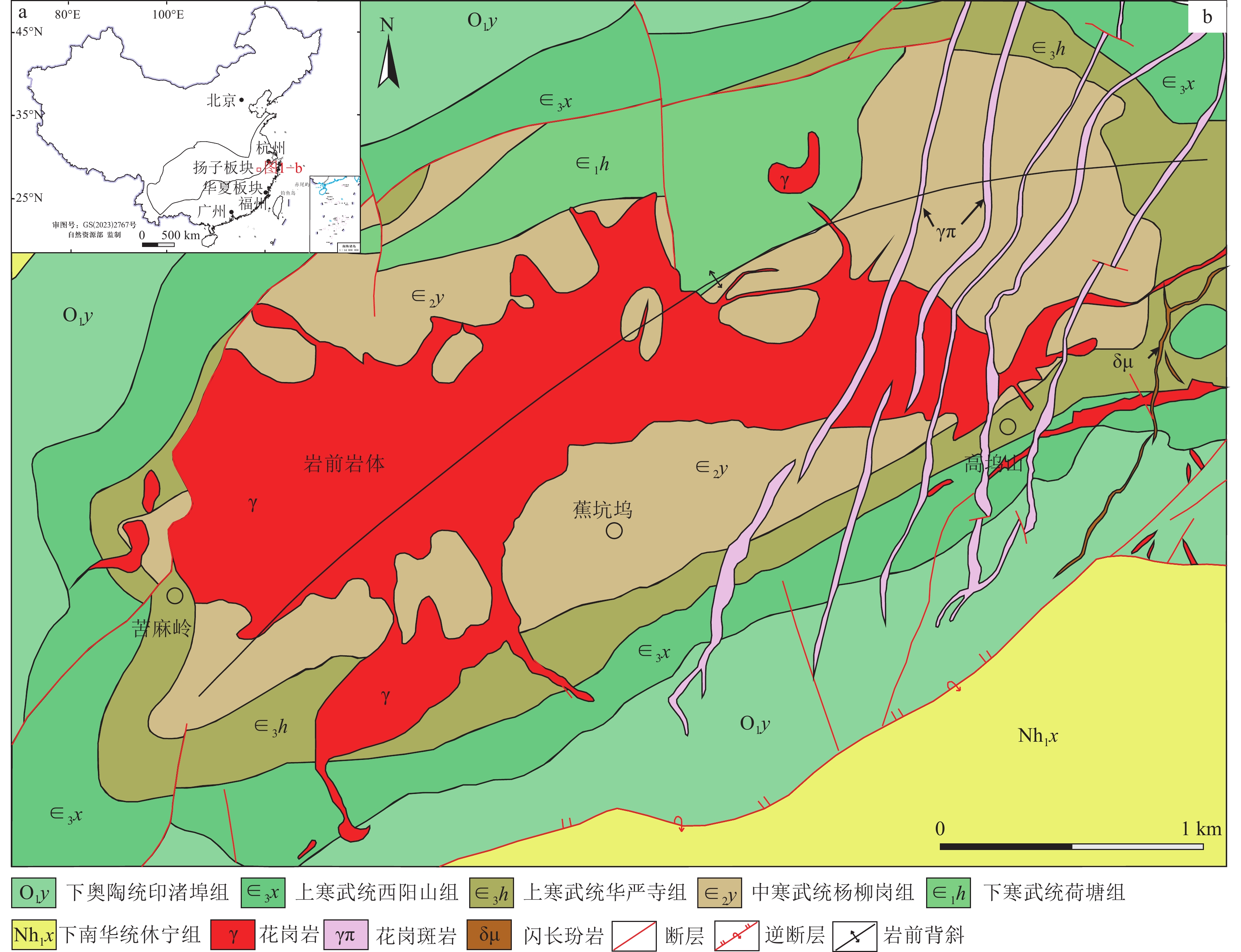
 下载:
下载:
